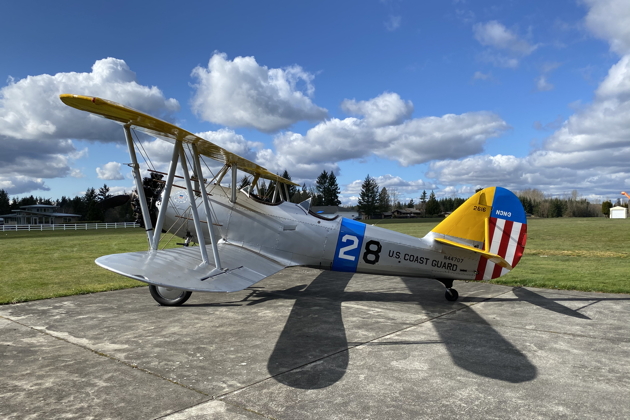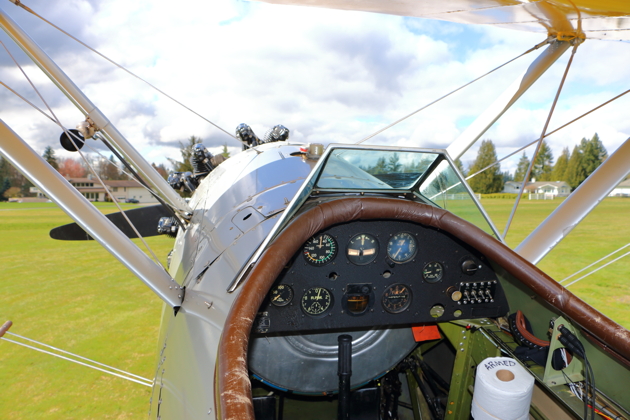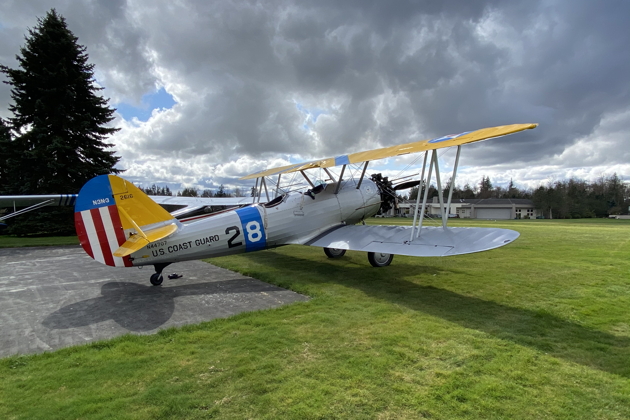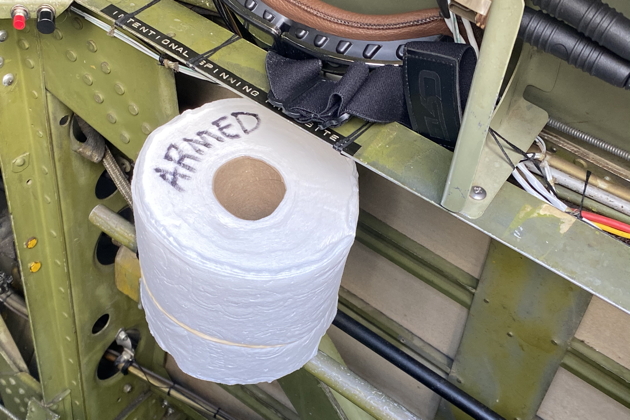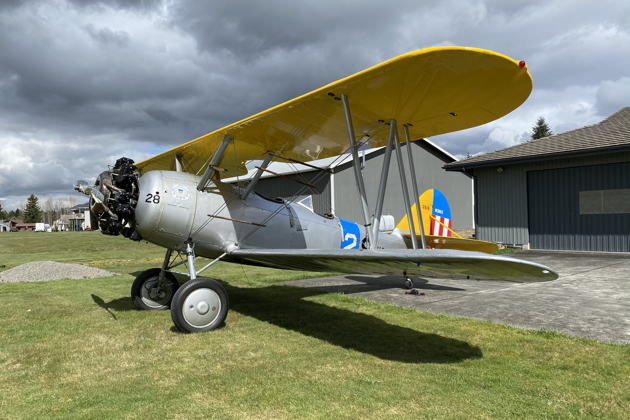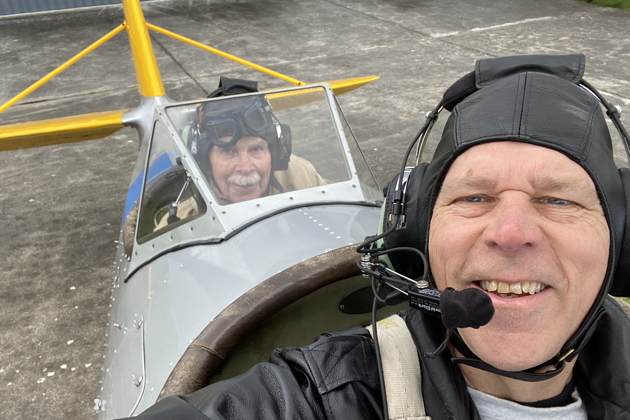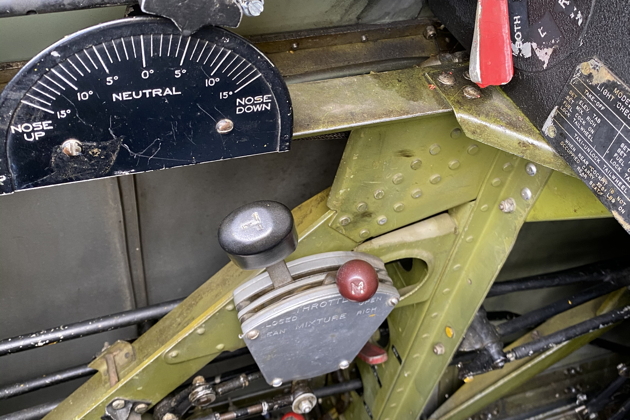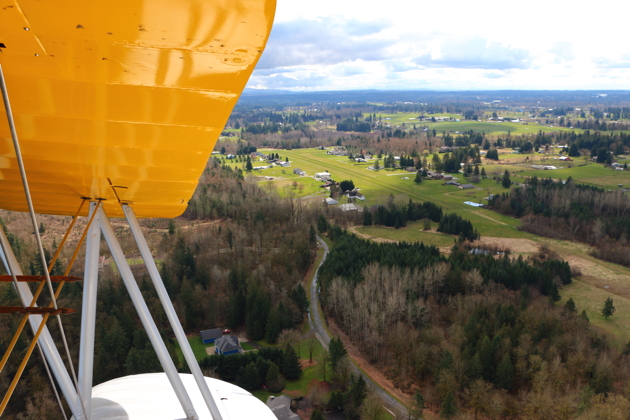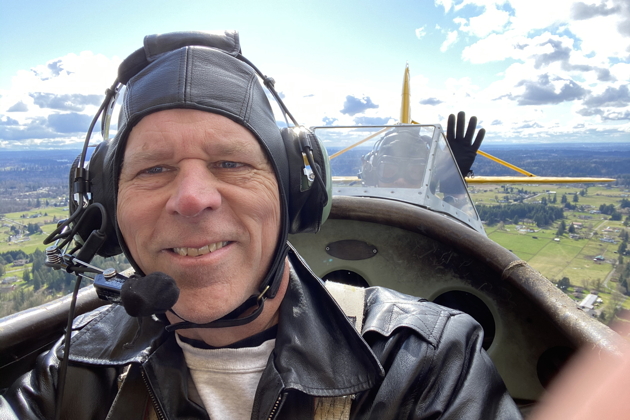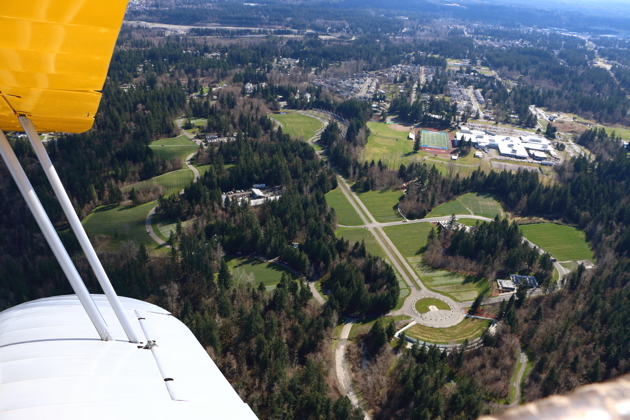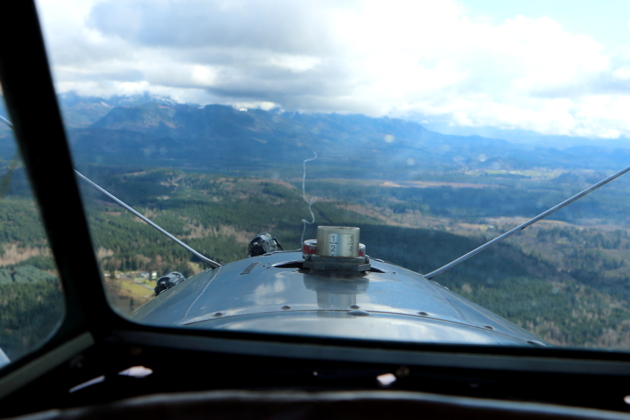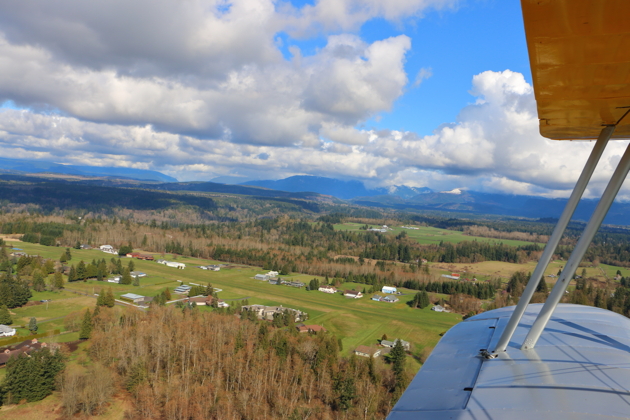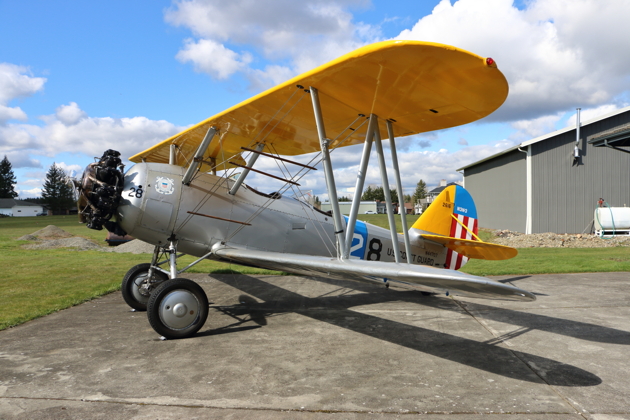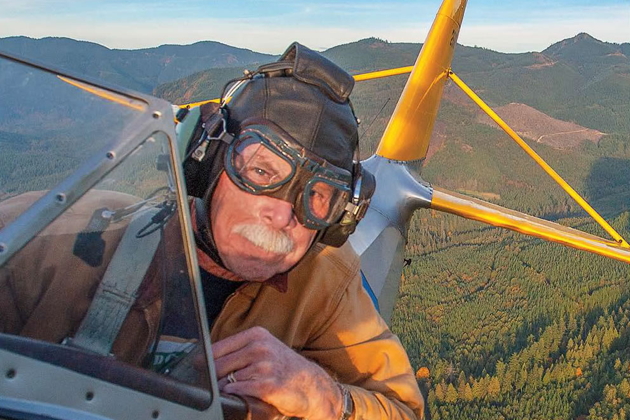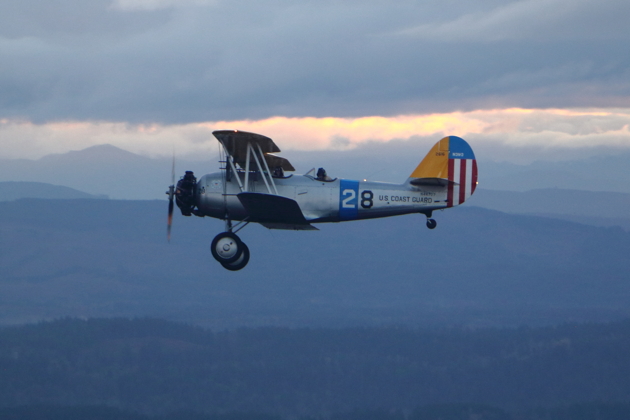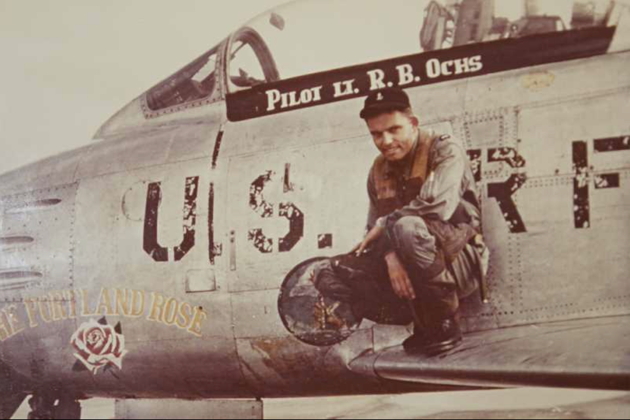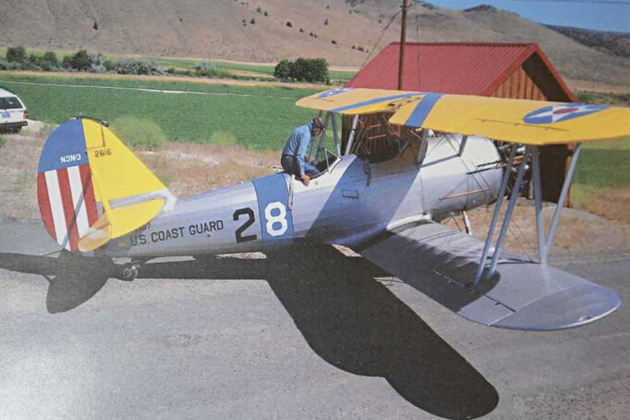FlightLog Archive
∟Aircraft Flown
Flying the N3N - Mar 2021
In November 2020, Tom and Marian Jensen had flown their beautifully restored N3N in support of our Auburn Veterans flyby. After our formation briefing, Tom mentioned that he'd be glad to let me fly with him in his N3N, since Marian rarely wanted him to fly solo. In December, Tom called to offer me an N3N flight, but I was already in the air in my Warrior. I successfully made an intercept of Tom using ADS-B while flying back from Tacoma Narrows, and was able to rejoin for a decent air-to-air N3N photo.
The N3N is a primary training biplane that was designed and built by the U.S. Navy at the Naval Aircraft Factory in Philadelphia, PA. The general configuration was traditional for the mid-1930s: Radial engine, tandem open cockpits, conventional tailwheel configuration and fabric covering for much of the structure. Under the covering, the design was very unique for the time with an entirely aluminum structure for the wings, fuselage and tail. A number of the beams, shapes and formers were leftovers from the Navy dirigible program. The entire left side of the fuselage has removable aluminum panels allowing quick and easy access to all internal components. Tom's aircraft, an N3N-3, was the final variant of the N3N, with a production of 816 aircraft. All early N3N aircraft were delivered with the Navy-built Wright R-760-2 engine, later upgraded to the much more reliable R-760-8. The Navy had the manufacturing rights to produce the engines from Curtis Wright. The N3N-3 was the only WWII era naval aircraft that was approved for intentional inverted spins.
The N3N is often confused with the more prevalent Stearman. Both aircraft were designed in 1934, with the N3N produced in two major versions, wheels and floats. There are three major differences between the N3N and the Stearman:
Wing construction - The N3N has an aluminum wing, extruded aluminum spars and sheet aluminum ribs. The Stearman has a wing made entirely of wood.
Fuselage construction - The N3N has a riveted, extruded aluminum fuselage, while the Stearman has a welded steel tube fuselage (like a Piper Cub).
Aspect ratio is one of the biggest differences. The N3N has a wing that is nearly 2 feet longer but the chord is 3 inches narrower.
Most N3N-3 aircraft were declared surplus during and immediately after World War II, but about 100 airframes were kept by the Navy. The N3N was no longer used for primary training but stayed in service to provide orientation rides for midshipmen at the Naval Academy in the seaplane configuration. They continued in use until 1961, making the N3N-3 the longest serving (and last serving) biplane in the U.S. military.
N3N N44707 was restored by Ron Ochs in 1985 after a seven year restoration. After flying F-86s in Korea, Ron wanting to restore an antique plane, and bought an N3N crop duster, then started collecting parts. "It was hard to find parts, so I had to buy entire junk piles for parts. I sold that plane and built another N3N out of the junk pile." Ron had the original data plate, so N3N N44707 became a restoration, not a replica. According to Ron's son Ben, the N3N was always hangared, flown well and cared for, with Ron applying the paint and engine work and winning numerous awards for his restoration. Tom Jensen acquired the N3N after a demonstration flight with Ben. The brakes were original drum brakes when Tom acquired it, and were OK after adjustment, but only worked well for a couple of flights after they were adjusted. Tom Jensen installed new disc brakes, which did wonders for ground handling.
After a thorough pre-flight orientation and startup, Tom had me maneuver down the taxiway at Evergreen Sky to get a feel for ground handling and vision over the nose. The new brakes were excellent, and the only thing I noticed after taxiing was the amount of back stick pressure needed while taxiing could cause development of 'Popeye arms' quite quickly. Tom let me fly two takeoffs, with coaching to relax back stick pressure at 40 knots, then raise the tail. I had decent peripheral vision with my tall sitting height, then good forward visibility once the tail came up. Almost immediately, with a very slight bit of aft stick pressure, we were airborne and climbing smoothly, enjoying the open cockpit airflow, blocked quite effectively by the small windshield in front. Visibility was outstanding, except by the area blocked by the wings, of course. The four ailerons provided excellent roll control, so clearing for traffic while maneuvering became a joy. I settled to a cruise throttle setting at 1750 RPM, and reveled in the handling and visibility on this glorious Spring afternoon.
Besides the primary goal of aircraft orientation, we had two other missions to accomplish. I was coordinating a missing man flyby the next day over the Tahoma National Cemetery, and Tom had received word that the memorial service would be held in an area surrounded in trees on three sides, necessitating a change to our normal north-to-south run in. Tom and I flew a practice run in from east-to-west in the N3N, noting landmarks and headings, with great vis from the open cockpit of our 'target'.
The second mission also entailed a 'target', specifically air-to-air against a falling roll of streaming toilet paper. Tom gave me too much credit for my former F-15 air-to-air, with no coaching other than 'Go For It', and made me jettison the first roll at 3500 feet over open forest and try as many 'intercepts' as possible before a 2500 foot safety floor, with no help. The streamer descended much faster than I had first anticipated, but luckily, fighter pilot instinct kicked in, and I was able to make two successful 'intercepts' on the target before 2500 feet. The maneuverability of the N3N was excellent, especially in roll! Tom jettisoned a second 'target' from the back seat for his passes, nicking the top of the descending streamer on two of his passes.
With the earlier missions accomplished, we then proceeded on our 'backup' mission, namely flying over the White River, using the great N3N maneuverability to stay with every bend and turn as we followed the White River toward Auburn. As the population on the edges of the river increased, we headed back to Evergreen Sky. Tom demoed a smooth turning final and greased the N3N on to the grass runway.
Thanks, Tom (with a newly assigned tactical callsign of 'T.P.') for this great introduction to the N3N. It was the perfect aircraft to fly as the 100th different aircraft that I've flown over the years! I'm ready for summer and more air-to-air!
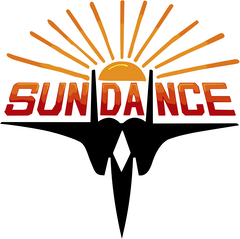 KASPRZYK
KASPRZYK